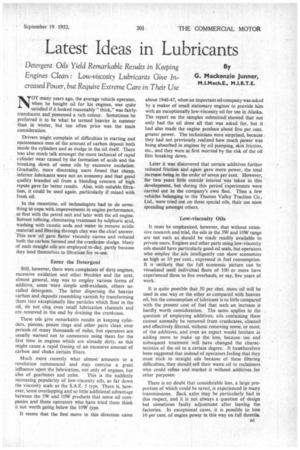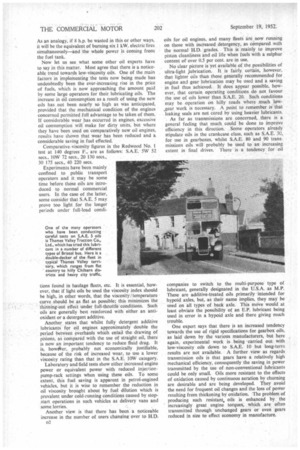Latest Ideas in Lubricants
Page 75

Page 76

If you've noticed an error in this article please click here to report it so we can fix it.
By
G. Mackenzie Junner, m.i.Mech.E., M.I.R.T.E.
NOT many years ago, the average vehicle operator, when he bought oil for his engines, was quite satisfied if it looked reasonably " thick," was fairly. translucent and possessed a rich colour. Sometimes he preferred it to be what he termed heavier in summer than in winter, but too often price was the main consideration.
Drivers might complain of difficulties in starting and maintenance men of the amount of carbon deposit both inside the cylinders and as sludge in the oil itself. There was also much talk amongst the more technical of rapid cylinder wear caused by the formation of acids and the breaking down of some oils by excessive oxidation. Gradually, more discerning users found that cheap, inferior lubricants were not an economy and that good quality branded oil from a blending concern of high repute gave far better results. Also, with suitable filtration, it could be used again, particularly if mixed with fresh oil.
In the meantime, oil technologists had to do something to cope with improvements in engine performance, at first with the petrol unit and later with the oil engine. Solvent refining, eliminating treatment by sulphuric acid, washing with caustic soda and water to remove acidic material and filtering through clay was the chief answer. This new oil gave flatter viscosity curves and reduced both the carbon formed and the crankcase sludge. Many of such straight oils are employed to-day, partly because they lend themselves to filtration for re-use.
Enter the Detergent Still, however, there were complaints of dirty engines, excessive oxidation and other troubles and the next, almost general, step was to employ various forms of additive, some were simple anti-oxidants, others socalled detergents. The latter dispersing the heavier carbon and deposits resembling varnish by transforming them into exceptionally fine particles which float in the oil, do not clog even small lubrication channels and are removed in the end by draining the crankcase.
These oils give remarkable results in keeping cylinders, pistons, piston rings and other parts clean over periods of many thousands of miles, but operators are usually warned not to commence using them for the first time in engines which are already dirty, as this might cause a rapid freeing of an excessive amount of carbon and choke certain filters.
Much more recently what almost amounts to a revolution commenced and may exercise a great influence, upon the lubrication, not only of engines, but
also of gearboxes and axles. This is the suddenly increasing popularity of low-viscosity oils, as far down the viscosity scale as the S.A.E. 5 type. There is, however, some overlapping and so little additional advantage between the 5W and 10W products that some oil companies and those operators who have tried. them think it not worth going below the lOW type.
It seems that the first move in this direction came about 1946-47, when an important oil company was asked by a maker of small stationary engines to provide him with an exceptionally low-viscosity oil for use in Alaska. The report on the samples submitted showed that not only had the oil done all that was asked for, but it had also made the engine produce about five per cent. greater power. The technicians were surprised, because they had not previously realized how much power was being absorbed in engines by oil pumping, skin friction, etc., and they were at first worried by the risk of the oil film breaking down.
Later it was discovered that certain additives further reduced friction and again gave more power, the total increase being in the order of seven per cent. However, for two years little outside interest was taken in this development, but during this period experiments were carried out in the company's own fleet. Then a few vehicles belonging to the Thames Valley Traction Co., Ltd., were tried out on these special oils, their use soon spreading amongst others.
Low-viscosity Oils It must be emphasized, however, that without extensive research and trial, the oils in the .5W and lOW range are not such as should be made readily available to private users. Engines and other parts using low-viscosity oils should have particularly good oil seals, but operators who employ the oils intelligently can show economies as high as 10 per cent., expressed in fuel consumption. It is unlikely that the full economic picture can be visualized until individual fleets of 100 or more have experienced three to five overhauls, or say, five years of work.
It is quite possible that 50 per cent. more oil will be used in one way or the other as compared with heavier oil, but the consumption of lubricant is so little compared with the present cost of fuel that such an increase is hardly worth consideration. The same applies to the question of employing additives; oils containing these cannot normally be removed from crankcases, cleaned and effectively filtered, without removing some, or most, of the additives, and even an expert would hesitate at adding more to make up the loss, because use and subsequent treatment will have changed the characteristics of the oil to a certain degree. It hassitherefore been suggested that instead of operators feeling that they must stick to straight oils because of these filtering difficulties, they should sell their waste oil to reelaimers who could refine and market it without additives for other purposes.
There is no doubt that considerable loss, a large proportion of which could be saved, is experienced in many transmissions. Back axles may be particularly bad in this respect, and it is not always a question of design but sometimes faulty adjustment after leaving the factories. In exceptional cases, it is possible to lose 10 per cent. of engine power in this way on full throttle. As an analogy, if 8 h.p. be wasted in this or other ways, it will be the equivalent of burning six 1 kW. electric fires simultaneously—and the whole power is coming from the fuel tank.
Now let us see what some other oil experts have to say in this matter. Most agree that there is a noticeable trend towards low-viscosity oils. One of the main factors in implementing the tests now being made has undoubtedly been the ever-increasing rise in the price of fuels, which is now approaching the amount paid by some large operators for their lubricating oils. The increase in Oil consumption as a result of using the new oils has not been nearly so high as was anticipated, provided that the mechanical condition of the engines concerned permitted full advantage to be taken of them. If considerable wear has occurred in engines, excessive oil consumption will make for dirty units, but where they have been used on comparatively new oil engines, results have shown that wear has been reduced and a considerable saving in fuel effected.
Comparative..viscosity figures in the Redwood No. 1 test at 140 degrees F., are as follows: S.A.E. 5W 52 secs.. IOW 72 secs., 20 130 secs., 30 175 secs., 40 220 secs.
Experiments have been mainly confined to public transport operators and it may be some time before those oils are introduced to normal commercial users. In the case of the latter, some consider that S.A.E. 5 may prove too light for the longer periods under full-load condi
tions found in haulage fleets, etc. It is essential, however, that if light oils be used the viscosity index should be high, in other words, that the viscosity/temperature curve should be as flat as possible; this minimizes the thinning-out effect under full-ttu-ota' conditions. Such oils are generally best reinforced with either an antioxidant or a detergent additive.
Another states that whilst fully detergent additive lubricants for oil engines approximately double the period between overhauls which entail the drawing of pistons, as compared with the use of straight oil, there is now an important tendency to reduce fluid drag. It is, howoker, probably not economically justifiable, because of the risk of increased wear, to use a lower viscosity rating than that in the S.A.E. 10W category.
Laboratory and field tests show either increased engine power or equivalent power with reduced injection. pump-rack settings when using these oils. To some extent, this fuel saving is apparent in petrol-engined vehicles, but it is wise to remember the reduction in oil viscosity brought about by fuel dilution which is prevalent under cold-running conditions caused by stopstart operations in such vehicles as delivery vans and some lorries.
Another view is that there has been a noticeable increase in the number of users changing over to H.D.
oils for oil engines, and many fleets are now running on those with increased detergency, as compared with the normal H.D. grades. This is mainly to improve piston cleanliness and oil life when fuels with a sulphur content of over 0.5 per cent. are in use.
No clear picture is yet available of the possibilities of ultra-light ilubrication. It is fairly certain, however, that lighter oils than those generally recommended for. engine and gear lubrication may be used and a saving in fuel thus achieved. It does appear possible, however, that certain operating conditions do not favour the use of oils lower than S.A.E. 20. Such conditions may be operation on hilly roads where much low,gear work is necessary. A point to remember is that leaking seals are not cured by using heavier lubricants.
As far as transmissions are concerned, there is a general feeling that much could be done to improve efficiency in this direction. Some operators already stipulate oils in the crankcase class, such as S,A.E. 50, for use in gearboxes, whilst S.A.E. 80 and 90 transmissions oils will probably be used to an increasing extent in final drives. There is a tendency for oil
companies to switch to the multi-purpose type of lubricant, generally designated in the U.S.A. as M.P. These are additive-treated oils primarily intended for hypoid axles, but, as their name implies, they may be used on all types of back axle. This move would at least obviate the possibility of an E.P. lubricant being used in error in a hypoid axle and there giving much trouble.
One expert says that there is an increased tendency towards the use of rigid specifications for gearbox oils, as laid down by the various manufacturers, but here again, experimental work is being carried out with low-viscosity oils down to S.A.E. 10 but long-term results are not available. A further view as regards transmission oils is that gears have a relatively high mechanical efficiency, consequently the saving in power transmitted by the use of non-conventional lubricants could be only small. Oils more resistant to the effects of oxidation caused by continuous aeration by churning are desirable and are being developed. They avoid the need for frequent oil changes and the loss of power resulting from thickening by oxidation. The problem of producing such resistant, oils is enhanced by the increasingly great engine torques, which are often transmitted through unchanged gears or even gears reduced in size to effect economy in manufacture.




































































































































































